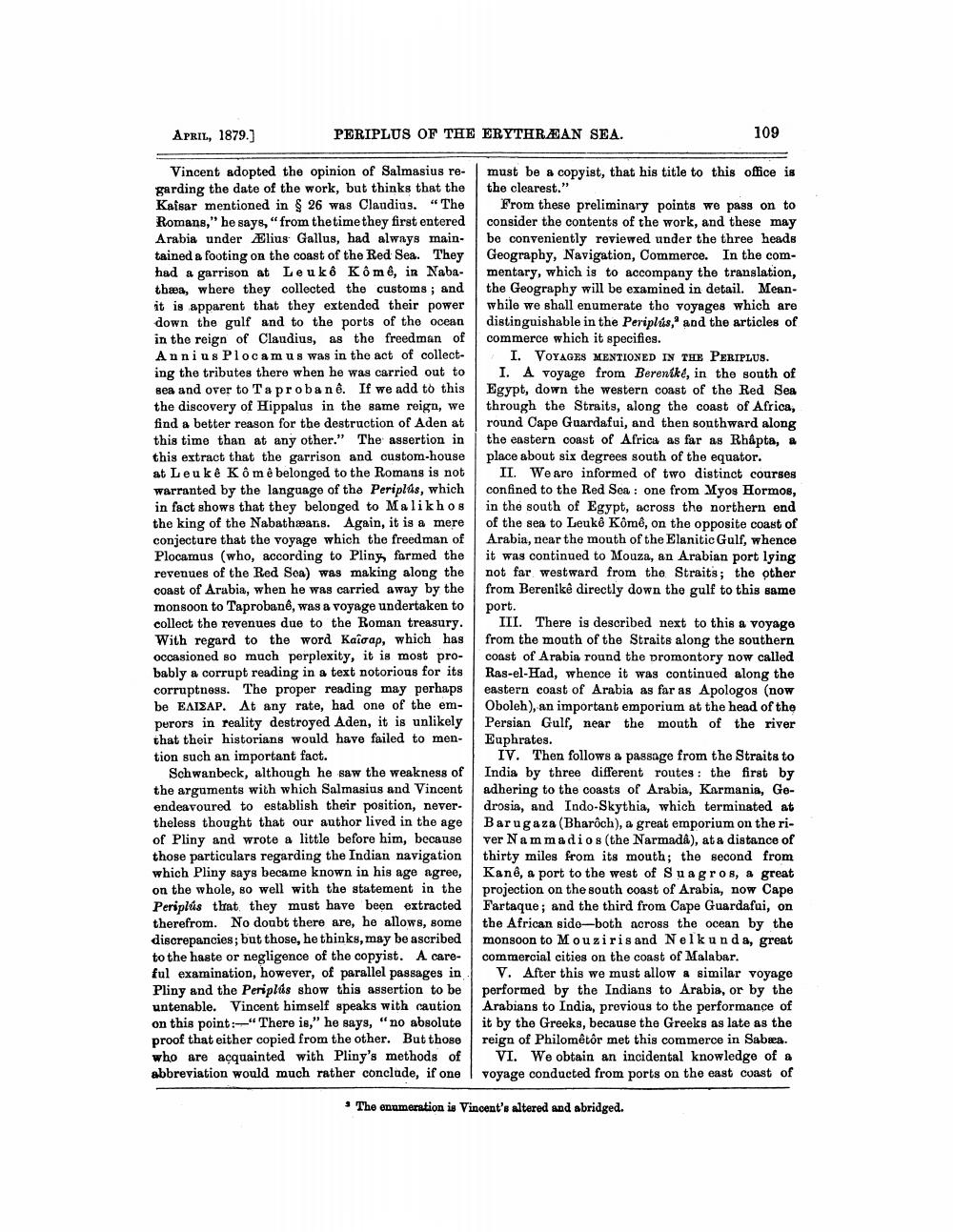________________
APRIL, 1879.]
PERIPLUS OF THE ERYTHRÆAN SEA.
109
Vincent adopted the opinion of Salmasius regarding the date of the work, but thinks that the Kaisar mentioned in § 26 was Claudius. "The Romans," he says, "from the time they first entered Arabia under Ælius Gallus, had always main- tained a footing on the coast of the Red Sea. They had a garrison at Leukô Kôme, in Nabathæa, where they collected the customs; and it is apparent that they extended their power down the gulf and to the ports of the ocean in the reign of Claudius, as the freedman of Annius Plocamus was in the act of collecting the tributes there when he was carried out to sea and over to Ta probanê. If we add to this the discovery of Hippalus in the same reign, we find a better reason for the destruction of Aden at this time than at any other." The assertion in this extract that the garrison and custom-house at Leuké Kôm ê belonged to the Romans is not warranted by the language of the Periplus, which in fact shows that they belonged to Malikhos the king of the Nabathæanis. Again, it is a mere conjecture that the voyage which the freedman of Plocamus (who, according to Pling farmed the revenues of the Red Sea) was making along the coast of Arabia, when he was carried away by the monsoon to Taprobanê, was a voyage undertaken to collect the revenues due to the Roman treasury. With regard to the word Kaioap, which has occasioned so much perplexity, it is most probably a corrupt reading in a text notorious for its corruptness. The proper reading may perhaps be EAIZAP. At any rate, had one of the emperors in reality destroyed Aden, it is unlikely that their historians would have failed to mention such an important fact.
Schwanbeck, although he saw the weakness of the arguments with which Salmasius and Vincent endeavoured to establish their position, nevertheless thought that our author lived in the age of Pliny and wrote a little before him, because those particulars regarding the Indian navigation which Pliny says became known in his age agree, on the whole, so well with the statement in the Periplus that they must have been extracted therefrom. No doubt there are, he allows, some discrepancies; but those, he thinks, may be ascribed to the haste or negligence of the copyist. A careful examination, however, of parallel passages in Pliny and the Periplts show this assertion to be untenable. Vincent himself speaks with caution on this point:--"There is," he says, "no absolute proof that either copied from the other. But those who are acquainted with Pliny's methods of abbreviation would much rather conclude, if one
must be a copyist, that his title to this office is the clearest."
From these preliminary points we pass on to consider the contents of the work, and these may be conveniently reviewed under the three heads Geography, Navigation, Commerce. In the commentary, which is to accompany the translation, the Geography will be examined in detail. Meanwhile we shall enumerate the voyages which are distinguishable in the Periplús, and the articles of commerce which it specifies.
I. VOYAGES MENTIONED IN THE PERIPLUS. I. A voyage from Berenike, in the south of Egypt, down the western coast of the Red Sea through the Straits, along the coast of Africa, round Cape Guardafui, and then southward along the eastern coast of Africa as far as Rhapta, a place about six degrees south of the equator.
II. We are informed of two distinct courses confined to the Red Sea : one from Myos Hormos, in the south of Egypt, across the northern end of the sea to Leuké Kômê, on the opposite coast of Arabia, near the mouth of the Elanitic Gulf, whence it was continued to Mouza, an Arabian port lying not far westward from the Straits; the other from Berenikê directly down the gulf to this same port.
III. There is described next to this a voyage from the mouth of the Straits along the southern coast of Arabia round the promontory now called Ras-el-Had, whence it was continued along the eastern coast of Arabia as far as Apologos (now Oboleh), an important emporium at the head of the Persian Gulf, near the mouth of the river Euphrates.
IV. Then follows a passage from the Straits to India by three different routes: the first by adhering to the coasts of Arabia, Karmania, Gedrosia, and Indo-Skythia, which terminated at Barugaza (Bharôch), a great emporium on the river Nammadios (the Narmada), at a distance of thirty miles from its mouth; the second from Kane, a port to the west of Su agros, a great projection on the south coast of Arabia, now Cape Fartaque; and the third from Cape Guardafui, on the African side-both across the ocean by the monsoon to Mouziris and Nelkunda, great commercial cities on the coast of Malabar.
V. After this we must allow a similar voyage performed by the Indians to Arabia, or by the Arabians to India, previous to the performance of it by the Greeks, because the Greeks as late as the reign of Philomêtor met this commerce in Sabæa.
VI. We obtain an incidental knowledge of a voyage conducted from ports on the east coast of
• The enumeration is Vincent's altered and abridged.




